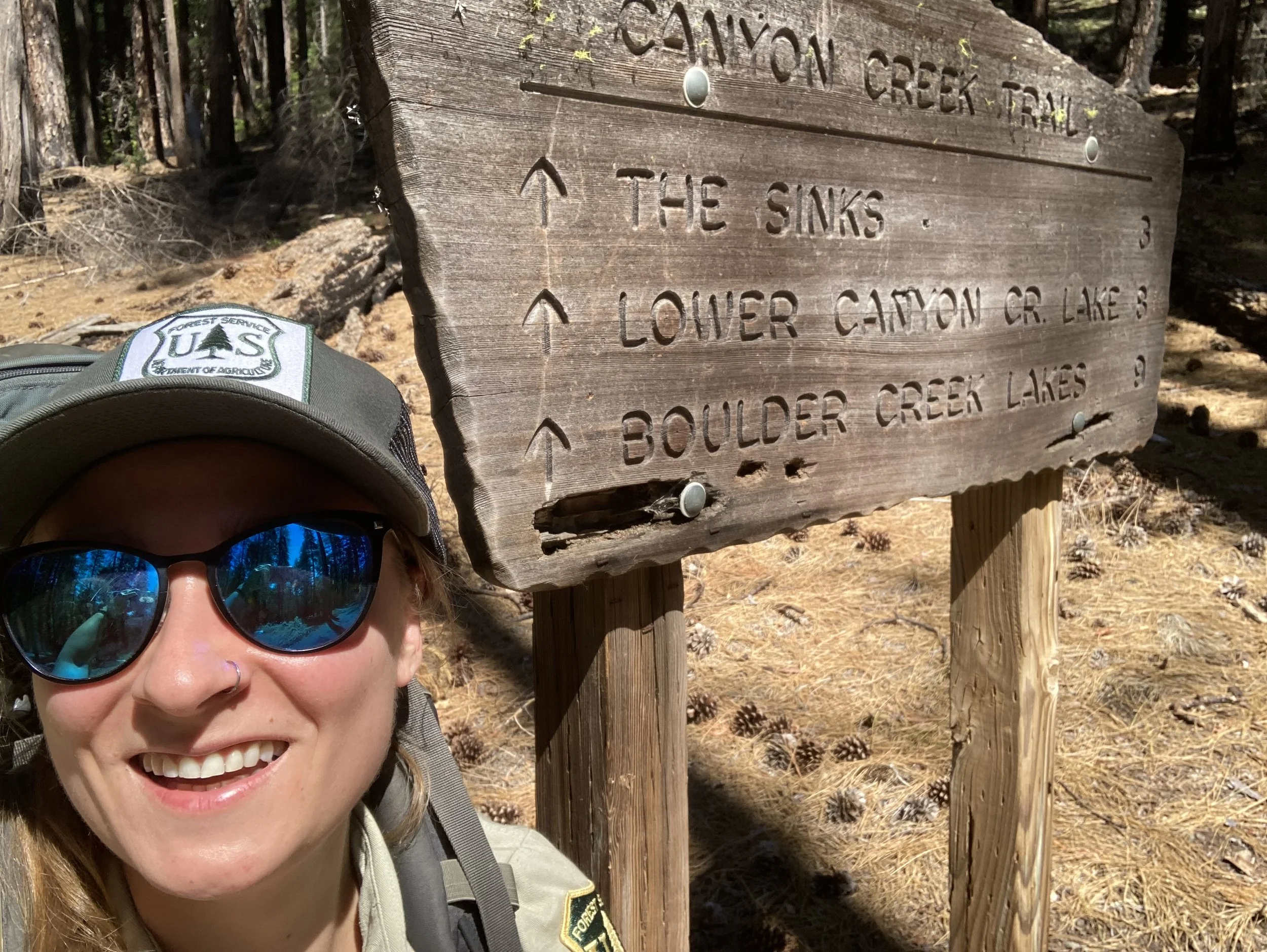The Inside Scoop on WRTC Wilderness Patrolling
“What do you even do out there on your wilderness patrols?”
I heard this question numerous times from the public during my tenure at Olympic National Park, and from coworkers here at the Watershed Center who know me as the social media and website manager.
One of many traditional pre-patrol selfies showcasing the trailhead sign.
My answer always emphasizes the customer service element, providing weather, trail, and wildfire information as a preventative search and rescue measure, and assistance to recreators when needed–everything from medical intervention to help with bear hangs or stream crossings.
Most consistently I haul garbage. I inspect every known campsite for microtrash and, when the fire ring is legal and long-established, I shovel out the ashes, often sifting to separate tin foil and other non-biodegradable detritus, and scatter the coals and ash into nearby shrubs. This prevents campers from stacking rocks ever higher to contain the flames. When I discover an illegal fire ring, I dismantle it, hucking rocks into water or inaccessible crevices, scattering the coals, and covering the fire scar with dirt and duff. Illegal fire rings are often found at higher elevations where wood is scarce and must be left in place to decompose and create soil for subalpine flora. Many illegal rings are found right next to lakeshores, damaging sensitive surfaces and marring the wilderness character.
“No resource damage on my watch!” I’ll mutter to myself, erasing evidence of past campers. Or, after dismantling 20+ illegal rings in a two-hour timeframe, I might briefly succumb to a cynical streak and sigh, “This is why we can’t have nice things.”
My fellow wilderness patroller, Matilda Hofman, has had similar experiences. “I’ve found trash of all sorts, everything from fishing-line, to beer bottles, to clothing likely stolen by a mischievous deer. Once I came across many pounds of plastic and food trash half buried at Morris Meadows–far too many pounds for me to carry for another 4 days of patrolling. Luckily someone from the Shasta-Trinity Unit of the Backcountry Horsemen of CA was also at the meadows and kindly offered to pack it out.”
Some trash is lightweight, compactable, and easy to hike out.
Other refuse can weigh too much for a solo patroller to haul.
By and large I’ve found the backpacking and day-hiking populace visiting Trinity County to be trending toward well-practiced Leave No Trace Principles and a shared sense of stewardship for these beautiful, but markedly trodden, places. Although some trips have been harder than others, Matilda echoes the same sentiment, insisting that, “Campers and backpackers are usually enthusiastic to support wilderness ethics and our work. One family helped me dismantle a fire-pit which was made of unusually large and heavy rocks. Being out there on wilderness patrol adds to and encourages a sense of shared community and stewardship of our natural public spaces.”
“The Trinity Alps are such an incredibly beautiful and special place, and I feel grateful to play a small part in taking care of them.”
I now have several seasons of patrolling to look back upon, and the experience has been a privilege. Having worked in National Parks in Washington and Alaska and road tripped numerous times throughout the American West, I have seen more than my fair share of stunning, awe-inspiring natural places. To have stumbled upon Trinity County and made a permanent home here has been a tremendous blessing. The opportunities to hike to subalpine lakes and scale rugged peaks are endless. I expect I would need a few hundred lifetimes to visit every drainage in these mountainous forests. Patrolling has increased the pace at which I visit and care for these wild spaces, and for that I am extremely grateful.
The other question I’m most often asked is, “Are you a ranger?”
And technically, no! I’m not. “I used to be a park ranger in a few places, but I’m not currently. As a member of one of the U.S. Forest Service’s local partnering organizations, I’m contracted to bolster the wilderness staff and because of my previous training, they asked me if I’d be interested.” I leapt at the chance and look forward to gearing up as much as the schedule permits.
Most of my assignments occur over busy holiday weekends, when I’ll contact well over a hundred recreators up Canyon Creek, the most heavily visited drainage in the Trinity Alps. In my early Trinity patrol days, when we were still recovering from the pandemic, I was sent to some of the most remote locations in the county, performing what trail duties I could with a handsaw and pipcutters. One time, up in Eagle Creek Benches, I didn’t see another soul for two full days. Cow patties, a few errant arrows, and one eerily broken-down tent were the only indications that the place was semi-regularly visited by humans as the trail itself often petered out into an untraceable suggestion, reclaimed by the meadow.
I have cut back brush, hauled small trees off the trail, shoveled wrapper- and foil-filled bear poop into my trash bag, built legal campfires for novice recreators, and buried human feces in my tenure here. I have carried heavy packs in 90+ degree heat and run interference for helicopters scooping water for fire suppression in lakes where swimmers were too enraptured by the airship to move.
It’s serious and beautiful business being out in the backcountry, responsible for the safety of all within hiking distance. And I wouldn’t miss a patrol for anything in the world.
Cover photo taken by Matilda Hofman.
This work is made possible by the Trinity County Resource Advisory Committee and funded through Title 2 of the Secure Rural Schools Act managed by the U. S. Forest Service, Department of Agriculture.






